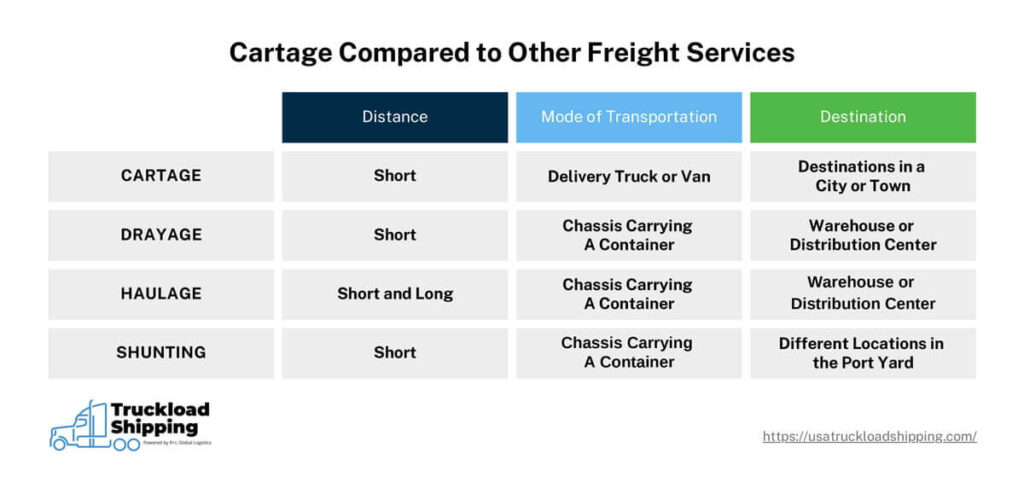Cartage service is just one of many options that shippers use in the transportation industry. It is a specialized and common service used by shippers to deliver goods to businesses and residences. But what exactly is cartage, and what is its place in the supply chain?
Key Takeaways
In this article, we will explain how to use cartage and highlight the key similarities and differences it has with other freight services.
Cartage is the process of moving goods over short distances. This service is often used to transport goods within a metropolitan area or a small town.
Most carriers don't offer cartage services because they focus on long-distance shipping. As a result, shippers must opt to find cartage agents that will transport their light haul shipment of goods over the short distances that long-distance carriers won't cover.
Cartage companies use small delivery trucks or vans to transport their customer's goods as LTL or less than truckload shipments.
To utilize cartage services, there are about three steps that you will have to follow:
The cartage advice document contains critical information about your shipment like its destination, quantity of goods, and the type(s) of goods being moved. It is similar to a bill of lading (BOL).
Cartage services are used when goods need to be transported a short distance to a certain location, like a residential area or business. However, there are other instances where cartage is used to move goods within a limited geographical area.
An FTZ is an area into which imported goods may be brought for operations prior to domestic distribution. These zones are often extremely close to ports where goods are imported and exported by cargo vessels.
Goods that are in free trade zones can be taken to a port for re-exportation out of the country. Cartage services come in handy for scenarios like this because the goods only need to travel a short distance to the port from which they will be re-exported.
Probably the most common and obvious form of cartage service is the one that transports goods within a city or small town. Since destinations are so close together in areas like these, it doesn't make sense to pay for the services of a normal long-haul shipment.
Instead, cartage companies will take on this responsibility, using smaller vehicles to transport shipments within these more compact, densely-populated areas.
Even though cartage is a unique service, it shares elements with other types of ground transportation services. Cartage has so much in common with other transportation services that it's sometimes used interchangeably with services like drayage or haulage.
Since there is so much confusion between cartage and other transportation services, it’s important to understand how cartage is both similar and different from these.
Some of the services that cartage gets confused with are:
Let’s take a look at these services and how they compare and contrast with cartage.
Cartage and drayage services both focus on short-distance transport of shipments. In the case of drayage services, freight usually travels no farther than 250 miles from the port at which it’s received.
The difference between the two services lies in where the freight is transported. Freight that is transported using drayage is typically delivered to a warehouse or distribution center. Once the containers arrive, the freight inside is divided into smaller shipments.
On the other hand, cartage services can transport bulk shipments and shipments that have already been broken down into smaller ones. Smaller shipments are transported to destinations in cities or metropolitan areas.
Another difference between these two services is what the freight is transported in.
Drayage services transport freight within a cargo container, while cartage services transport freight within either a truck or a van.
For more information about these two services, consult our complete overview on drayage vs cartage.
Cartage and haulage are two services that have more differences than they do similarities. Rather than using small trucks or vans, haulage services transport freight in shipping containers either by truck or rail.
Haulage services, like cartage, transport freight over short distances but can also transport freight over long distances. There are also two different types of haulage services: carrier and merchant haulage. They differ based on whether the shipper makes the cartage arrangements (merchant) or if the carrier handles them in addition to other services.
Both shunting and cartage services are transportation services that cover short distances. While cartage deals with moving freight over short distances between warehouses, DCs, and end users, shunting focuses more on moving entire containers within a port yard.
Containers can either be empty or they can be loaded to the brim with freight. Cartage services will transport freight to areas within cities and towns. Shunting, however, moves containers short distances within the port area.
The table below sums up the differences and similarities between all four functions we’ve discussed.

If you’re looking for cartage freight services for your bulk shipment, USA Truckload Shipping is the company you need. We have experience in providing shippers with carriers that can transport their bulk shipment of products.
From heavy haul to hazmat and flatbed shipping, our team has relationships with various carriers that offer these types of services. We can provide you with a full suite of truckload freight services, including:.
Start your relationship with USA Truckload Shipping by filling out a risk-free proposal request online or giving us a call at (866) 353-7178 today!
R+L Global Logistics
315 NE 14th St., Ocala, FL 34470